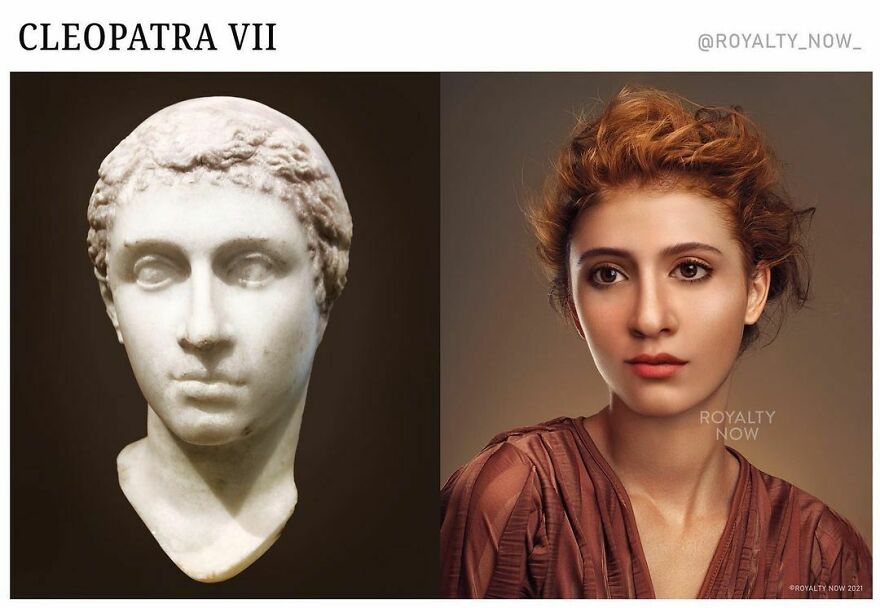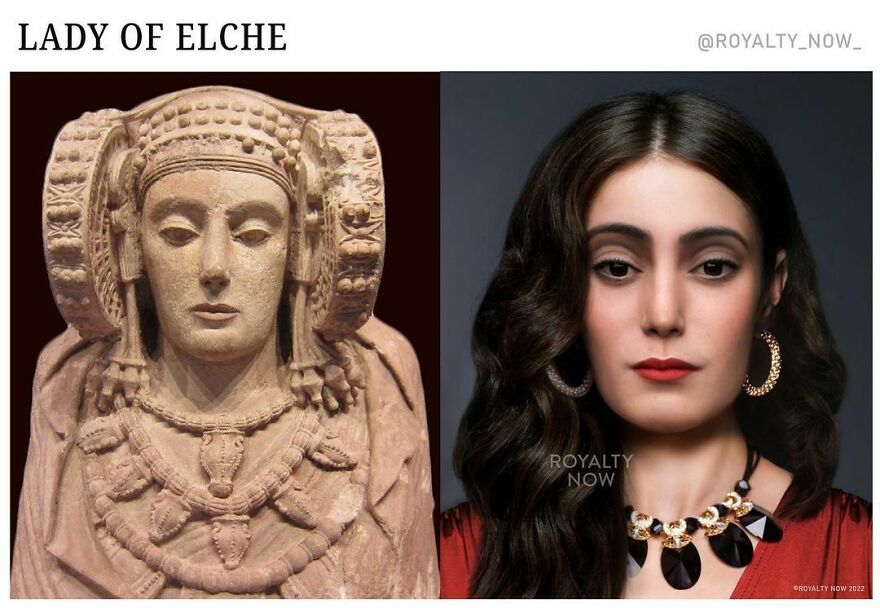There are many people you can recognize without knowing them personally or having met them. Einstein with his signature hair and mustache, or the beautiful features of Marilyn Monroe, to name a few. We often become familiar with their appearance through pictures, but how do we visualize historical figures that many of them have not let us see?
No need to let your imagination run wild to imagine what they would look like today. Becca Saladin has successfully covered it for you again. He breathed new life into other portraits of historical figures that we can't wait to share with you. Scroll down to see what you would find if you met Napoleon Bonaparte or Alexander the Great on the street tomorrow.
#1 Queen Nefertiti
"A modern interpretation of the Berlin bust of Queen Nefertiti".

#2 Alexander The Great
There are dozens of images of Alexander that can be seen around the world, including coins, busts, and full-length statues. Despite the wealth of images available to us today, most are believed to be later copies of lost originals. It is clear that depictions of him in the Greek style were idealized.
What would it be like if he were to appear before us today? First of all, Alexander was what we would now consider a modern Greek. He was born in Pella, Macedonia, near the tip of what is now the Greek peninsula, to parents from Greek kingdoms. Descriptions of him from his life mostly agree that he had blond or golden hair, fair skin that was possibly a bit flushed, and a handsome face with a prominent forehead. He was also stocky and muscular, perhaps just over 5 feet tall. An interesting fact about his appearance is that he may have had heterochromia, a condition in which the eyes are two different colors or a mottled combination of the two. I put a brown spot on his right eye to reflect this gripping tale.
#3 Cleopatra

“Was Cleopatra red-haired? I have to admit I was kind of against that idea for a while, considering she was probably at least 75% Greek and Middle Eastern, I automatically thought black hair. However, I wanted to do more research and come up with a redhead version of her from the Berlin bust, which I think is a pretty accurate likeness of the Egyptian queen.
Proof that she is a redhead can be found in a few photos which are unconfirmed but could very possibly be Cleo. These are frescoes from Pompeii and Hurculaneum, as well as a cameo made around her life showing her with bright red hair. Descriptions of frescoes by Dr. Joann Fletcher: "Painted picture from a villa in Herculaneum, representing a red-haired woman, whose features, royal diadem, and hairstyle adorned with fine pearled pins suggest a posthumous portrait of Cleopatra VII ." So what do you think about it?"
#4 Shakespeare

"There is no provenance for this painting, but if it were Shakespeare it would be the only true-to-life image of him. Here are some reasons why it might be him: The clothes the model were popular between 1590 and 1610, the period when Shakespeare was at his greatest success and therefore more likely to pose for a portrait. The gold earring suggests a usual "bohemian" look for a playwright. the subject, because of his all-back outfit, loose black tint was quite expensive.
I also wanted to share another exciting collaboration between KLEIO and Royalty Now: presenting A Midsummer Night's Dream. Inspired by its namesake, one of Shakespeare's most famous works, this candle recreates the scents of a familiar scene.
What fascinates me about this candle is that they are all scents that Shakespeare would have known during his lifetime. In fact, it may even encourage you to experience the works of Shakespeare in new ways...and gain a new perspective on how he engaged the senses in his work.
#5 Lady of Elche

The Lady of Elche has always fascinated me with her interesting hairstyle and delicately sculpted face. Turns out the statue is pretty mysterious too. It was discovered in 1897 on private property south of Elche in Spain and is generally believed to be an Iberian artifact from the 4th century BC. However, it was initially dismissed by scholars, believing the craft to be incompatible with other Iberian artifacts of the time. It is thought to be a goddess, Tanit, worshiped by the Punic Iberians in antiquity. However, some scholars argue that the design and style of the sculpture suggests Hellenistic influences. Originally the bust was brightly painted with shades of red, blue and yellow.
The mysterious nature and inability to locate it in Spanish history has fueled speculation that it is a fake. However, increasing discoveries of other artifacts in recent years have shown this to be untrue. The Lady of Elche was actually the first Iberian sculpture discovered to be painted in bright colors, which originally made it stand out, but recent finds show that it was not uncommon after all. Traces of pigments in the statue correspond to ancient materials and colors.
Conspiracy theorists even said it was a lost Atlantean artifact. In fact, her "Rodette" headdress may be a link to the concentric circles associated with the lost city.
There is an interesting hole in the back of the sculpture which may have originally contained human ashes. This led researchers to conclude that it was probably a funerary urn. However, whether it was intended to represent the deceased is up for debate. It's always fun to work with him!
 Richelle Johnson
Richelle Johnson